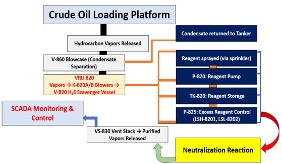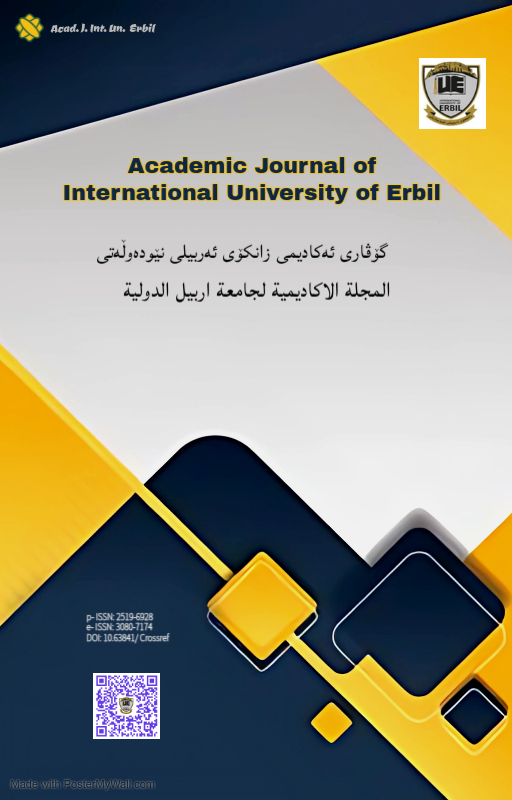Mitigating Emissions and Improving Vapor Recovery Efficiency: A Comprehensive Analysis of Vapor Recovery Systems in Crude Oil Loading Operations
DOI:
https://doi.org/10.63841/iue24599Keywords:
Volatile Organic Compounds (VOCs), Vapor Recovery Unit (VRU), Environmental And Occupational Impact, Emissions Assessment; Air Quality, Regulatory Compliance, Technological Advancements, Real-time Monitoring, Vapor Recovery System (VRS), Crude Oil LoadingAbstract
This review investigates the role and efficiency of Vapour Recovery Systems (VRS) implementation during crude oil loading operations, evaluating their influences on volatile organic compound emissions reduction, mitigating occupational health risks, enhancing environmental sustainability and economic benefits. This research indicates that VRS reduces VOC emissions by up to 95%, effectively mitigating air pollution and noticeably decreasing environmental pollution. Mitigated hydrocarbon exposure through VRS due to VRS installation significantly contributed to a decline in symptoms such as dizziness, headaches, and respiratory distress. From a financial standpoint, mitigating VOC emissions and maintaining regulatory standards yielded notable economic profits. Developed technology adoption like DCS, timely monitoring and analytical maintenance, enhances operational efficiency, recovery rates and minimising downtime effectively. This study underscores the comprehensive integrative value of VRS in revealing its capability to simultaneously advance operational efficiency, ecological sustainability, occupational health safety, and cost-effectiveness across petroleum operations.
References
S. S. Virdi, L. Y. Lee, C. Li, and A. K. Dev, “Simulation of VOC Emission During Loading Operations in a Crude Oil Tanker,” Int. J. Marit. Eng., vol. 163, no. A1, pp. 1–16, Apr. 2021, doi: 10.5750/ijme.v163iA1.1.
M. Kamel and K. Al Shehhi, “VOC Recovery System for Crude Oil Tanker Loading,” in ADIPEC, SPE, Oct. 2022. doi: 10.2118/210906-MS.
S. Lee, I. Choi, and D. Chang, “Multi-objective optimisation of VOC recovery and reuse in crude oil loading,” Appl. Energy, vol. 108, pp. 439–447, Aug. 2013, doi: 10.1016/j.apenergy.2013.03.064.
M. A. DeLuchi, “Emissions from the Production, Storage, and Transport of Crude Oil and Gasoline,” Air Waste, vol. 43, no. 11, pp. 1486–1495, Nov. 1993, doi: 10.1080/1073161X.1993.10467222.
M. Tamaddoni, R. Sotudeh-Gharebagh, S. Nario, M. Hajihosseinzadeh, and N. Mostoufi, “Experimental study of the VOC emitted from crude oil tankers,” Process Saf. Environ. Prot., vol. 92, no. 6, pp. 929–937, Nov. 2014, doi: 10.1016/j.psep.2013.10.005.
K. K. Koundinya, S. Mondal, and A. Bose, “An overview of worldwide regulations on oil pollution control,” in Advances in Oil-Water Separation, Elsevier, 2022, pp. 65–82. doi: 10.1016/B978-0-323-89978-9.00001-X.
J. KARL, E. FIŠEROVÁ, and D. MAXA, “EXPLOSIVENESS OF HYDROCARBON VAPOURS IN INDUSTRIAL INSTALLATIONS UNDER VARIOUS CONDITIONS,” Aug. 2020, pp. 89–99. doi: 10.2495/RISK200081.
L. Järup, “Hazards of heavy metal contamination,” Br. Med. Bull., vol. 68, no. 1, pp. 167–182, Dec. 2003, doi: 10.1093/bmb/ldg032.
B. Shingan, S. Timung, S. Jain, and V. P. Singh, “Technological horizons in natural gas processing: A comprehensive review of recent developments,” Sep. Sci. Technol., vol. 59, no. 10–14, pp. 1216–1240, Sep. 2024, doi: 10.1080/01496395.2024.2366914.
D. T. Allen et al., “Measurements of methane emissions at natural gas production sites in the United States,” Proc. Natl. Acad. Sci., vol. 110, no. 44, pp. 17768–17773, Oct. 2013, doi: 10.1073/pnas. 1304880110.
F. Zhang et al., “Significant impact of coal combustion on VOCs emissions in winter in a North China rural site,” Sci. Total Environ., vol. 720, p. 137617, Jun. 2020, doi: 10.1016/j.scitotenv.2020.137617.
H. R. Karbasian, D. Y. Kim, S. Y. Yoon, J. H. Ahn, and K. C. Kim, “A new method for reducing VOCs formation during crude oil loading process,” J. Mech. Sci. Technol., vol. 31, no. 4, pp. 1701–1710, Apr. 2017, doi: 10.1007/s12206-017-0318-7.
M. V. da Silva Neves and A. F. Flutt, “Energy Efficiency in Oil Production Facilities,” 2024, pp. 29–73. doi: 10.1007/978-3-031-54274-9_5.
E. Thompson, “Safety Guidelines for Handling Flammable Vapours,” Occup. Saf. Publ., 2019.
E. Salter and J. Ford, “Environmental Pollution Challenges and Associated Planning and Management Issues Facing Offshore Oil and Gas Field Development in the UK,” J. Environ. Plan. Manag., vol. 43, no. 2, pp. 253–276, Mar. 2000, doi: 10.1080/09640560010702.
H. Rajabi, M. Hadi Mosleh, P. Mandal, A. Lea-Langton, and M. Sedighi, “Emissions of volatile organic compounds from crude oil processing – Global emission inventory and environmental release,” Sci. Total Environ., vol. 727, p. 138654, Jul. 2020, doi: 10.1016/j.scitotenv.2020.138654.
D. Elsom, Smog Alert. Routledge, 2014. doi: 10.4324/9781315070469.
M. R. Riazi, M. S. Rana, and J. L. Peña Díez, “Worldwide Statistical Data on Proven Reserves, Production, and Refining Capacities of Crude Oil and Natural Gas,” in Petroleum Refining and Natural Gas Processing, ASTM International100 Barr Harbor Drive, PO Box C700, West Conshohocken, PA 19428-2959, 2013, pp. 33–78. doi: 10.1520/MNL5820131211503.
R. Schmalensee and R. N. Stavins, “Policy Evolution under the Clean Air Act,” J. Econ. Perspect., vol. 33, no. 4, pp. 27–50, Nov. 2019, doi: 10.1257/jep 33.4.27.
G. R. Parmar and N. N. Rao, “Emerging Control Technologies for Volatile Organic Compounds,” Crit. Rev. Environ. Sci. Technol., vol. 39, no. 1, pp. 41–78, Dec. 2008, doi: 10.1080/10643380701413658.
K. Cullinane and S. Cullinane, “Atmospheric Emissions from Shipping: The Need for Regulation and Approaches to Compliance,” Transp. Rev., vol. 33, no. 4, pp. 377–401, Jul. 2013, doi: 10.1080/01441647.2013.806604.
V. P. Meshalkin and E. A. Babakov, “Improvement of the adsorption-absorption vapour recovery unit for cleaning the gas-air mixture from volatile organic compounds and hydrogen sulfide when loading naphtha on marine tankers,” Proc. Vor. State Univ. Eng. Technol., vol. 84, no. 2, pp. 243–248, Jun. 2022, doi: 10.20914/2310-1202-2022-2-243-248.
D. J. X. Gonzalez, C. K. Francis, G. M. Shaw, M. R. Cullen, M. Baiocchi, and M. Burke, “Upstream oil and gas production and ambient air pollution in California,” Sci. Total Environ., vol. 806, p. 150298, Feb. 2022, doi: 10.1016/j.scitotenv.2021.150298.
C. D. Koolen and G. Rothenberg, “Air Pollution in Europe,” ChemSusChem, vol. 12, no. 1, pp. 164–172, Jan. 2019, doi: 10.1002/cssc 201802292.
C. A. Stroud, C. Zaganescu, J. Chen, C. A. McLinden, J. Zhang, and D. Wang, “Toxic volatile organic air pollutants across Canada: multi-year concentration trends, regional air quality modelling and source apportionment,” J. Atmos. Chem., vol. 73, no. 2, pp. 137–164, Jun. 2016, doi: 10.1007/s10874-015-9319-z.
B. Wang, T. Jiang, and N. Wang, “Absorption and condensation of VOCs,” in Volatile Organic Compound Removal, Elsevier, 2024, pp. 135–152. doi: 10.1016/B978-0-443-15674-8.00011-1.
G. AL-khulaidi, Y. Sun, A. G. Alareqi, A.-W. Ibrahim, A. Magaji, and X. Zhang, “Review on Carbon Capture, Utilisation, and Storage for Enhancing Gas Recovery,” Energy & Fuels, vol. 38, no. 10, pp. 8355–8384, May 2024, doi: 10.1021/acs.energyfuels.3c05211.[28] Varec, G. V. Chilingarian, and S. Kumar, “Chapter 6 Vapour Recovery,” 1987, pp. 149–175. doi: 10.1016/S0376-7361(08)70535-1.
M. A. Goodyear, A. L. Graham, J. B. Stoner, B. E. Boyer, and L. P. Zeringue, “Vapour Recovery of Natural Gas Using Non-Mechanical Technology,” in SPE/EPA/DOE Exploration and Production Environmental Conference, SPE, Mar. 2003. doi: 10.2118/80599-MS.
C. Greco, P. Kotak, L. Pagnotta, and C. Lamuta, “The evolution of mechanical actuation: from conventional actuators to artificial muscles,” Int. Mater. Rev., vol. 67, no. 6, pp. 575–619, Aug. 2022, doi: 10.1080/09506608.2021.1971428.
Y. Zhang et al., “Species profiles and normalised reactivity of volatile organic compounds from gasoline evaporation in China,” Atmos. Environ., vol. 79, pp. 110–118, Nov. 2013, doi: 10.1016/j.atmosenv.2013.06.029.
T. Paulauskienė, V. Zabukas, and P. Vaitiekūnas, “Investigation of volatile organic compound (voc) emission in oil terminal storage tank parks/lakiųjų organinių junginių (loj) emisijos tyrimas naftos terminalo talpyklų parkuose/ исследование эмиссии легколетучих органических соединений (лос) в парках рез,” J. Environ. Eng. Landsc. Manag., vol. 17, no. 2, pp. 81–88, Jun. 2009, doi: 10.3846/1648-6897.2009.17.81-88.
M. Abkowitz, G. List, and A. E. Radwan, “Critical Issues in Safe Transport of Hazardous Materials,” J. Transp. Eng., vol. 115, no. 6, pp. 608–629, Nov. 1989, doi: 10.1061/(ASCE)0733-947X(1989)115:6(608).
S. Mokhatab, W. A. Poe, and J. Y. Mak, J.Y., Handbook of natural gas transmission and processing: principles and practices. 54. Gulf Professional Publishing, 2018.
K. Kamel, M., & Al Shehhi, “Paper presented at the ADIPEC,” Pap. Present. ADIPEC’, no. Abu Dhabi, UAE, October 2022.
M. Amaris, C., Vallès, M. and Bourouis, “Vapour absorption enhancement using passive techniques for absorption cooling/heating technologies: A review,” Appl. Energy, pp.826-853, 2018.
H. Man et al., “VOCs evaporative emissions from vehicles in China: Species characteristics of different emission processes,” Environ. Sci. Ecotechnology, vol. 1, p. 100002, Jan. 2020, doi: 10.1016/j.ese.2019.100002.
E. Lu, H. Zhang, and Z. Zhu, “A novel design for vapour recovery units,” Comput. Chem. Eng., vol. 24, no. 2–7, pp. 1317–1322, Jul. 2000, doi: 10.1016/S0098-1354(00)00399-9.
S. M. Vargas-Vasquez and L. B. Romero-Zerón, “The Vapour Extraction Process: Review,” Pet. Sci. Technol., vol. 25, no. 11, pp. 1447–1463, Nov. 2007, doi: 10.1080/10916460500528979.
J. Smith, Environmental Controls in Oil and Gas Facilities. 2nd ed. Houston: Energy Publishing Group, 2020.
P. Dwivedi, V. Gaur, A. Sharma, and N. Verma, “Comparative study of removal of volatile organic compounds by cryogenic condensation and adsorption by activated carbon fibre,” Sep. Purif. Technol., vol. 39, no. 1–2, pp. 23–37, Oct. 2004, doi: 10.1016/j.seppur.2003.12.016.
R. M. Butler and I. J. Mokrys, “A New Process (VAPEX) For Recovering Heavy Oils Using Hot Water And Hydrocarbon Vapour,” J. Can. Pet. Technol., vol. 30, no. 01, Jan. 1991, doi: 10.2118/91-01-09.
Z. Cao, J. Zhang, and W. Pan, “A review on release and transformation behaviour of alkali metals during high-alkali coal combustion,” Sustain. Energy Technol. Assessments, vol. 70, p. 103966, Oct. 2024, doi: 10.1016/j.seta.2024.103966.
D. Bradley, G. A. Chamberlain, and D. D. Drysdale, “Large vapour cloud explosions, with particular reference to that at Buncefield,” Philos. Trans. R. Soc. A Math. Phys. Eng. Sci., vol. 370, no. 1960, pp. 544–566, Feb. 2012, doi: 10.1098/rsta 2011.0419.
C. Clement, “Vapour Recovery on Tankers from Design to Operation,” Mar. Technol. SNAME News, vol. 30, no. 03, pp. 178–187, Jul. 1993, doi: 10.5957/mt1.1993.30.3.178.
V. W. Pagé, “Gasoline and Kerosene Carburettors: Construction, Installation, Adjustment; a Simple, Comprehensive Treatise for Practical Men,” 1919.
F. Chiara and M. Canova, “A review of energy consumption, management, and recovery in automotive systems, with considerations of future trends,” Proc. Inst.. Mech. Eng. Part D J. Automob. Eng., vol. 227, no. 6, pp. 914–936, Jun. 2013, doi: 10.1177/0954407012471294.
G. Manes et al., “Realtime Gas Emission Monitoring at Hazardous Sites Using a Distributed Point-Source Sensing Infrastructure,” Sensors, vol. 16, no. 1, p. 121, Jan. 2016, doi: 10.3390/s16010121.
M. Zsombok, I. and Zöldy, “Modelling, simulation and validation of hybrid vehicle fuel consumption.” Acta Polytech. Hungarica, pp.61-74, 2023.
A. G. Olugbenga, A. E. Ochayi, S. Ogidi, and O. V. Ikirigbe, “Efficient Modeling and Simulation of Crude Oil Stabilization Processes: Integrating RSM and ASPEN HYSYS for Energy-Saving Modifications,” in SPE Nigeria Annual International Conference and Exhibition, SPE, Aug. 2024. doi: 10.2118/221663-MS.
H. Saadawi, “Ten Years’ Experience with Flare Gas Recovery Systems in Abu Dhabi,” in SPE Annual Technical Conference and Exhibition, SPE, Sep. 2013. doi: 10.2118/166133-MS.
V. Fetisov, “Analysis of numerical modelling of steady-state modes of methane–hydrogen mixture transportation through a compressor station to reduce CO2 emissions,” Sci. Rep.., vol. 14, no. 1, p. 10605, May 2024, doi: 10.1038/s41598-024-61361-3.
V. Fetisov, “Analysis of numerical modelling of steady-state modes of methane–hydrogen mixture transportation through a compressor station to reduce CO2 emissions,” Sci. Rep., p. p.10605, 2024, [Online]. Available: 3
M. Maljković, S. Vukša, P. Vidan, and I. Pavić, “Review of Cargo Operations on Crude Oil Tankers and Methods/Models Used for Optimisation and Improvement of Safety,” Časopis Pomor. Fak. Kotor - J. Marit. Sci., vol. 23, no. 1/2022, pp. 153–164, Jun. 2022, doi: 10.56080/jms220512.
B. Kazmi et al., “Process system analysis on oil processing facility and economic viability from oil well-to-tank,” SN Appl. Sci., vol. 3, no. 7, p. 682, Jul. 2021, doi: 10.1007/s42452-021-04635-z.
C. Yajun, L., Maoqing, L. and Yeqing, The optimal design of frequency conversion controlled vapour recovery system based on the flow and temperature signals. 2015, pp. 152–156.
L. Yajun, L. Maoqing, and C. Yeqing, “The optimal design of frequency conversion controlled vapour recovery system based on the flow and temperature signals,” in 2015 International Conference on Fluid Power and Mechatronics (FPM), IEEE, Aug. 2015, pp. 152–156. doi: 10.1109/FPM. 2015.7337103.
Y. Liu, W. Wang, Z. Wang, W. Wei, and J. Lumkes, “Frequency Conversion Controlled Vapor Recovery System by Temperature and Flow Signals: Model Design and Parameters Optimization,” Sep. 2013. doi: 10.4271/2013-01-2348.
A. Sadatshojaie and M. R. Rahimpour, “CO2 emission and air pollution (volatile organic compounds, etc.)–related problems causing climate change,” in Current Trends and Future Developments on (Bio-) Membranes, Elsevier, 2020, pp. 1–30. doi: 10.1016/B978-0-12-816778-6.00001-1.
J. Liang, L. Sun, C. Cheng, K. Wang, T. Zhu, and T. Li, “Advancing gasoline vapor recovery in oil depots: Integrating cooling and adsorption technologies,” Energy, vol. 313, p. 133823, Dec. 2024, doi: 10.1016/j.energy.2024.133823.
J. Awewomom et al., “Addressing global environmental pollution using environmental control techniques: a focus on environmental policy and preventive environmental management,” Discov. Environ., vol. 2, no. 1, p. 8, Feb. 2024, doi: 10.1007/s44274-024-00033-5.
C. Benson, C. Dimopoulos, C. D. Argyropoulos, C. Varianou Mikellidou, and G. Boustras, “Assessing the common occupational health hazards and their health risks among oil and gas workers,” Saf. Sci., vol. 140, p. 105284, Aug. 2021, doi: 10.1016/j.ssci.2021.105284.
N. Shinohara et al., “Exposure/Risk Assessment of Employees in Gasoline Refueling Stations with and Without the Efficacy of Vapor Recovery Systems in Mexico,” Int. J. Environ. Res. Public Health, vol. 22, no. 1, p. 10, Dec. 2024, doi: 10.3390/ijerph22010010.
T. Rengarajan, P. Rajendran, N. Nandakumar, B. Lokeshkumar, P. Rajendran, and I. Nishigaki, “Exposure to polycyclic aromatic hydrocarbons with special focus on cancer,” Asian Pac. J. Trop. Biomed., vol. 5, no. 3, pp. 182–189, Mar. 2015, doi: 10.1016/S2221-1691(15)30003-4.
X. Zhou, X. Zhou, C. Wang, and H. Zhou, “Environmental and human health impacts of volatile organic compounds: A perspective review,” Chemosphere, vol. 313, p. 137489, Feb. 2023, doi: 10.1016/j.chemosphere.2022.137489.
W.-Q. Chen and X.-Y. Zhang, “1,3-Butadiene: a ubiquitous environmental mutagen and its associations with diseases,” Genes Environ., vol. 44, no. 1, p. 3, Dec. 2022, doi: 10.1186/s41021-021-00233-y.
J. (Jim) Zhang, Y. Wei, and Z. Fang, “Ozone Pollution: A Major Health Hazard Worldwide,” Front. Immunol., vol. 10, Oct. 2019, doi: 10.3389/fimmu 2019.02518.
A. Hart, “A review of technologies for transporting heavy crude oil and bitumen via pipelines,” J. Pet. Explor. Prod. Technol., vol. 4, no. 3, pp. 327–336, Sep. 2014, doi: 10.1007/s13202-013-0086-6.
K. Schaefer, H. Hoffmann, I. Dormuth, C. Jahn, and S. M. Emeis, “VOC emission source strengths of tankers during refuelling activities determined by spectroscopic remote sensing and inverse dispersion modelling,” K. Schaefer, O. Lado-Bordowsky, A. Comeron, M. R. Carleer, and J. S. Fender, Eds., Feb. 2002, p. 247. doi: 10.1117/12.454432.
H. Agrawal, W. A. Welch, J. W. Miller, and D. R. Cocker, “Emission Measurements from a Crude Oil Tanker at Sea,” Environ. Sci. Technol., vol. 42, no. 19, pp. 7098–7103, Oct. 2008, doi: 10.1021/es703102y.
G. Ancione, R. Lisi, and M. F. Milazzo, “Human health risk associated with emissions of volatile organic compounds due to the ship-loading of hydrocarbons in refineries,” Atmos. Pollut. Res., vol. 12, no. 2, pp. 432–442, Feb. 2021, doi: 10.1016/j.apr.2020.12.004.
X. Baur et al., “Health risks in international container and bulk cargo transport due to volatile toxic compounds,” J. Occup. Med. Toxicol., vol. 10, no. 1, p. 19, Dec. 2015, doi: 10.1186/s12995-015-0059-4.
I. Manisalidis, E. Stavropoulou, A. Stavropoulos, and E. Bezirtzoglou, “Environmental and Health Impacts of Air Pollution: A Review,” Front. Public Heal., vol. 8, Feb. 2020, doi: 10.3389/fpubh 2020.00014.
P. Soleimani and E. Hakimi, “Perspective Chapter: Environmental Impact and Carbon Management Strategies within Natural Gas Production,” in Natural Gas in the 21st Century, IntechOpen, 2025. doi: 10.5772/intechopen 1007822.
I. A. Magomadov et al., “Using Ultra-Low Emission Burner for Zero Gas Flaring in Oil Fields,” in SPE Caspian Technical Conference and Exhibition, SPE, Nov. 2024. doi: 10.2118/223435-MS.
R. J. Simmons, C. C. Rodrigues, S. Stephen, M. A. Al Maflahi, and R. Y. Yousuf, “An Industrial Hygiene Study in Support of a Sustainability Initiative: Clean Air for All,” in Abu Dhabi International Petroleum Exhibition & Conference, SPE, Nov. 2017. doi: 10.2118/188860-MS.
A. F. Rachman and B. Priyono, “Tekno Ekonomi Vapour Recovery Unit (VRU) di SPBU Tanggerang,” MALCOM Indones. J. Mach. Learn. Comput. Sci., vol. 4, no. 1, pp. 92–98, Dec. 2023, doi: 10.57152/malcom.v4i1.1036.
D. Yanming & Jayalath, “Mobile broadband enabled cooperative approaches for Vulnerable Road User safety,” Queensland University of Technology, 2022. doi: 10.5204/thesis.eprints.232643.
H. Abudu, X. Cai, and B. Lin, “How upstream petroleum industry affects economic growth and development in petroleum producing countries: Evidence from Ghana,” Energy, vol. 260, p. 125139, Dec. 2022, doi: 10.1016/j.energy.2022.125139.
T. Smith, J., Adams, C. & Brown, “Volatile Organic Compound Management in the Oil Sector. London,” Environ. Stud. Inst.., 2021.

Downloads
Published
Issue
Section
License
Copyright (c) 2025 Academic Journal of International University of Erbil

This work is licensed under a Creative Commons Attribution-NonCommercial-NoDerivatives 4.0 International License.











